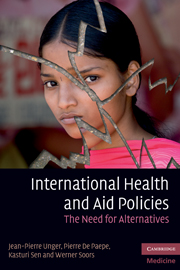Book contents
- Frontmatter
- Contents
- Preface
- Biographies
- Notices
- Acknowledgements
- List of abbreviations
- Reviews
- Introduction: Overview and purpose
- Section 1 Paradigms of international policies
- Section 2 The failure of the aid paradigm: poor disease control in developing countries
- Section 3 Impact of international health policies on access to health in middle-income countries: some experiences from Latin America
- Section 4 Determinants and implications of new liberal health policies: the case of India, China and Lebanon
- Section 5 Principles for alternative, publicly oriented health care policies, planning, management and delivery
- 12 Paradigm shifts in the health sector: mission and methods
- 13 Principles for an alternative, social and democratic health policy
- 14 Quality standards for health care delivery and management in publicly oriented health services
- 15 Principles of publicly oriented health planning
- 16 A code of good practice for the management of disease-control programmes
- Section 6 A public health, strategic toolkit to implement these alternatives
- Conclusions
- Glossary
- Index
- References
13 - Principles for an alternative, social and democratic health policy
Published online by Cambridge University Press: 06 December 2010
- Frontmatter
- Contents
- Preface
- Biographies
- Notices
- Acknowledgements
- List of abbreviations
- Reviews
- Introduction: Overview and purpose
- Section 1 Paradigms of international policies
- Section 2 The failure of the aid paradigm: poor disease control in developing countries
- Section 3 Impact of international health policies on access to health in middle-income countries: some experiences from Latin America
- Section 4 Determinants and implications of new liberal health policies: the case of India, China and Lebanon
- Section 5 Principles for alternative, publicly oriented health care policies, planning, management and delivery
- 12 Paradigm shifts in the health sector: mission and methods
- 13 Principles for an alternative, social and democratic health policy
- 14 Quality standards for health care delivery and management in publicly oriented health services
- 15 Principles of publicly oriented health planning
- 16 A code of good practice for the management of disease-control programmes
- Section 6 A public health, strategic toolkit to implement these alternatives
- Conclusions
- Glossary
- Index
- References
Summary
Adapted from: Unger J.-P., De Paepe J.-P., Ghilbert P., Soors W., Green A. Integrated care: a fresh perspective for international health policies in low and middle-income countries. International Journal of Integrated Care 2006; 6. ISSN 1568–4156.
Introduction
In Section 1, we reviewed the role that international aid and health policies have played in the disappointing health sector results in LMICs. Both policies are neoliberal in their promotion of commodification of health care. We argued that the combination of government-operated DSPs together with privatized health care services constrained both programme performance and people's access to care. Whilst we also recognized other factors that contributed to this failure (including, for example, state crisis, debt, corruption and patronage), we concluded that the only way forward was to support an alternative aid policy towards health services.
In this chapter we call for the promotion of a publicly oriented integrated health sector as a cornerstone of such a health policy, conceived to overcome the fragmentation and segmentation of LMIC health systems as it currently exists. We define ‘publicly oriented’ as opposed to ‘private for-profit’ in terms of objectives and commitment, not of (government vs. private) ownership. The combination of public aims and co-management with users and health professionals gives the name ‘social-and-democratic’ to such a policy.
We outline health system-specific strategies consistent with this policy, with the potential to improve both health care and disease control in LMICs.
- Type
- Chapter
- Information
- International Health and Aid PoliciesThe Need for Alternatives, pp. 164 - 175Publisher: Cambridge University PressPrint publication year: 2010



